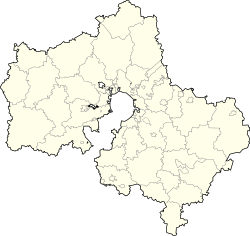You can help expand this article with text translated from the corresponding article in Russian. (March 2024) Click [show] for important translation instructions.
|
Dubna
Дубна | |
|---|---|
| Coordinates: 56°44′11″N 37°9′45″E / 56.73639°N 37.16250°E | |
| Country | Russia |
| Federal subject | Moscow Oblast[1] |
| Founded | 1956 |
| Government | |
| • Mayor | Maxim Tikhomirov |
| Elevation | 125 m (410 ft) |
| Population | |
• Total | 70,663 |
• Estimate (2012)[3] | 72,357 |
| • Rank | 223rd in 2010 |
| • Subordinated to | Dubna Town Under Oblast Jurisdiction[1] |
| • Capital of | Dubna Town Under Oblast Jurisdiction[1] |
| • Urban okrug | Dubna Urban Okrug[4] |
| • Capital of | Dubna Urban Okrug[4] |
| Time zone | UTC+3 (MSK |
| Postal code(s)[6] | 141980 |
| Dialing code(s) | +7 49621 |
| OKTMO ID | 46718000001 |
| Website | www |
Preview warning: Page using Template:Infobox Russian inhabited locality with unknown parameter "date"
Preview warning: Page using Template:Infobox Russian inhabited locality with unknown parameter "adm_data_as_of"
Preview warning: Page using Template:Infobox Russian inhabited locality with unknown parameter "mun_data_as_of"
Dubna (Russian: Дубна́, IPA: [dʊbˈna]) is a town in Moscow Oblast, Russia. It has a status of naukograd (i.e. town of science), being home to the Joint Institute for Nuclear Research, an international nuclear physics research center and one of the largest scientific foundations in the country. It is also home to MKB Raduga, a defense aerospace company specializing in design and production of missile systems, as well as to the Russia's largest satellite communications center owned by Russian Satellite Communications Company.[7] The modern town was developed in the middle of the 20th century and town status was granted to it in 1956. Population: 70,663 (2010 Census);[2] 60,951 (2002 Census);[8] 65,805 (1989 Soviet census).[9]
- ^ a b c d Cite error: The named reference
Ref1406was invoked but never defined (see the help page). - ^ a b Russian Federal State Statistics Service (2011). Всероссийская перепись населения 2010 года. Том 1 [2010 All-Russian Population Census, vol. 1]. Всероссийская перепись населения 2010 года [2010 All-Russia Population Census] (in Russian). Federal State Statistics Service.
- ^ Cite error: The named reference
2012Estwas invoked but never defined (see the help page). - ^ a b Cite error: The named reference
Ref777was invoked but never defined (see the help page). - ^ "Об исчислении времени". Официальный интернет-портал правовой информации (in Russian). 3 June 2011. Retrieved 19 January 2019.
- ^ Почта России. Информационно-вычислительный центр ОАСУ РПО. (Russian Post). Поиск объектов почтовой связи (Postal Objects Search) (in Russian)
- ^ "Ground infrastructure". Russian Satellite Communications Company.
- ^ Federal State Statistics Service (21 May 2004). Численность населения России, субъектов Российской Федерации в составе федеральных округов, районов, городских поселений, сельских населённых пунктов – районных центров и сельских населённых пунктов с населением 3 тысячи и более человек [Population of Russia, Its Federal Districts, Federal Subjects, Districts, Urban Localities, Rural Localities—Administrative Centers, and Rural Localities with Population of Over 3,000] (XLS). Всероссийская перепись населения 2002 года [All-Russia Population Census of 2002] (in Russian).
- ^ Всесоюзная перепись населения 1989 г. Численность наличного населения союзных и автономных республик, автономных областей и округов, краёв, областей, районов, городских поселений и сёл-райцентров [All Union Population Census of 1989: Present Population of Union and Autonomous Republics, Autonomous Oblasts and Okrugs, Krais, Oblasts, Districts, Urban Settlements, and Villages Serving as District Administrative Centers]. Всесоюзная перепись населения 1989 года [All-Union Population Census of 1989] (in Russian). Институт демографии Национального исследовательского университета: Высшая школа экономики [Institute of Demography at the National Research University: Higher School of Economics]. 1989 – via Demoscope Weekly.




